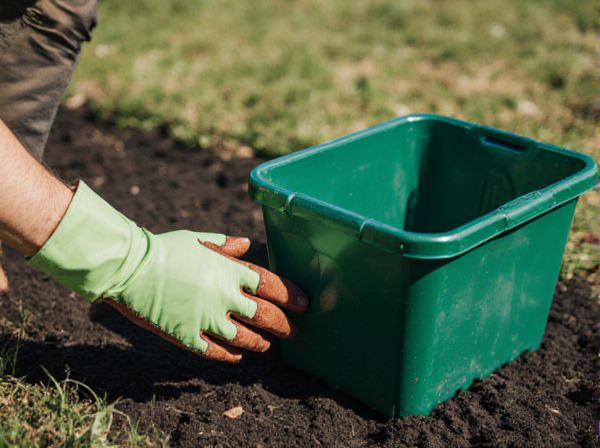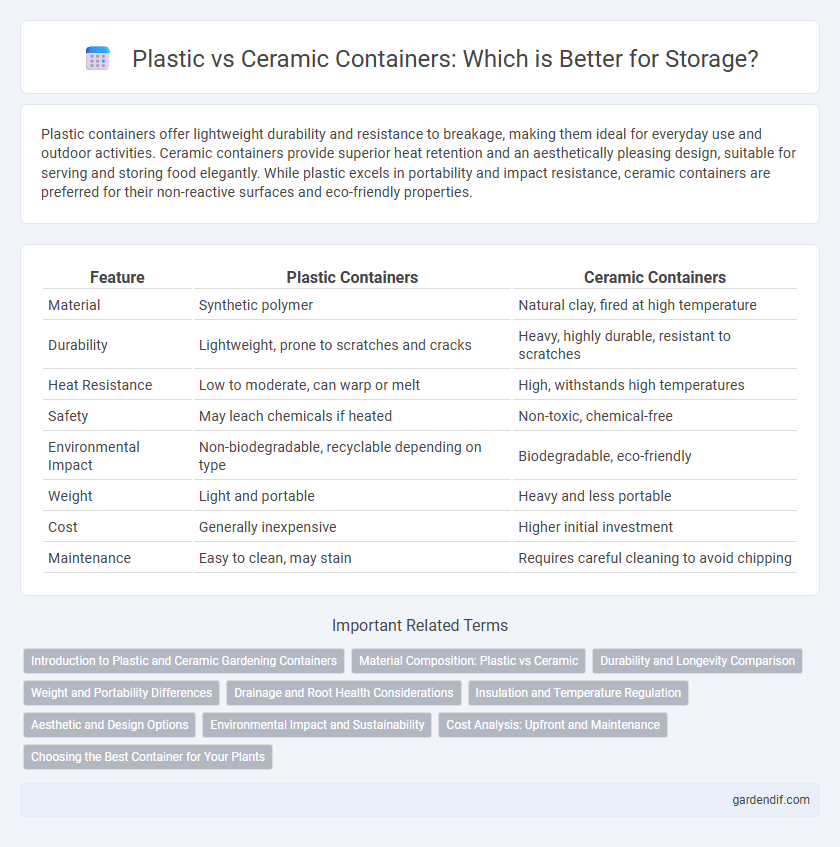
Plastic containers vs ceramic containers Illustration
Plastic containers offer lightweight durability and resistance to breakage, making them ideal for everyday use and outdoor activities. Ceramic containers provide superior heat retention and an aesthetically pleasing design, suitable for serving and storing food elegantly. While plastic excels in portability and impact resistance, ceramic containers are preferred for their non-reactive surfaces and eco-friendly properties.
Table of Comparison
| Feature | Plastic Containers | Ceramic Containers |
|---|---|---|
| Material | Synthetic polymer | Natural clay, fired at high temperature |
| Durability | Lightweight, prone to scratches and cracks | Heavy, highly durable, resistant to scratches |
| Heat Resistance | Low to moderate, can warp or melt | High, withstands high temperatures |
| Safety | May leach chemicals if heated | Non-toxic, chemical-free |
| Environmental Impact | Non-biodegradable, recyclable depending on type | Biodegradable, eco-friendly |
| Weight | Light and portable | Heavy and less portable |
| Cost | Generally inexpensive | Higher initial investment |
| Maintenance | Easy to clean, may stain | Requires careful cleaning to avoid chipping |
Introduction to Plastic and Ceramic Gardening Containers
Plastic gardening containers offer lightweight durability, affordability, and excellent moisture retention, making them ideal for both indoor and outdoor gardening. Ceramic containers provide superior insulation, enhancing root health by protecting against temperature fluctuations, and add aesthetic appeal with their varied designs and textures. Both container types support diverse plant growth, but selection depends on environmental conditions and gardener preferences.
Material Composition: Plastic vs Ceramic
Plastic containers are made from synthetic polymers such as polyethylene, polypropylene, or PET, offering lightweight and flexible properties ideal for portability and impact resistance. Ceramic containers consist of natural clay materials fired at high temperatures, resulting in a rigid, heat-resistant, and non-porous structure that provides superior thermal insulation and chemical stability. The choice between plastic's durability and ceramic's heat retention depends on usage requirements for food storage, microwave safety, and environmental impact.
Durability and Longevity Comparison
Plastic containers often provide excellent impact resistance and flexibility, making them less prone to cracking or breaking under rough handling, with durability largely influenced by the type of plastic used, such as high-density polyethylene (HDPE). Ceramic containers, while more brittle, offer superior resistance to scratching and chemical degradation, boasting longevity through their non-porous surface and ability to withstand high-temperature conditions without warping. Both materials are suitable for different use cases, with plastic containers favored for lightweight, portable storage and ceramic containers preferred for long-term food preservation and aesthetic appeal.
Weight and Portability Differences
Plastic containers are significantly lighter than ceramic containers, making them more convenient for travel and everyday portability. The lightweight nature of plastic reduces transport effort and is ideal for on-the-go use. Ceramic containers, while heavier and less portable, offer durability and aesthetic appeal but are impractical for situations requiring frequent movement.
Drainage and Root Health Considerations
Plastic containers offer superior drainage options due to their lightweight design and often built-in drainage holes, promoting efficient water flow that prevents root rot and supports healthy plant growth. Ceramic containers, while aesthetically pleasing, tend to retain moisture longer because of their dense material and limited drainage, which may increase the risk of overwatering and root decay. Choosing containers with appropriate drainage capabilities is essential for maintaining optimal root aeration and overall plant health.
Insulation and Temperature Regulation
Plastic containers generally offer limited insulation and can retain heat or cold for shorter periods, making them less effective for temperature regulation compared to ceramic containers. Ceramic containers provide superior insulation due to their dense material structure, maintaining stable temperatures and preserving the freshness of contents longer. This makes ceramic containers ideal for storing hot or cold foods that require consistent temperature control.
Aesthetic and Design Options
Plastic containers offer versatile aesthetic options with a wide range of colors, shapes, and finishes that cater to modern, minimalist, and vibrant design preferences. Ceramic containers provide a timeless, elegant appearance with intricate patterns, textured surfaces, and a matte or glossy finish that enhances rustic and traditional decor styles. Both materials allow customization, but ceramics excel in artisanal craftsmanship and surface detail, while plastics dominate in color variety and lightweight designs.
Environmental Impact and Sustainability
Plastic containers contribute significantly to environmental pollution due to their non-biodegradable nature and reliance on fossil fuels, leading to increased carbon emissions and landfill waste. Ceramic containers, made from natural clay, offer greater sustainability as they are reusable, recyclable, and have a lower environmental footprint over their lifecycle. Choosing ceramic containers reduces plastic waste and supports eco-friendly practices, promoting long-term environmental health.
Cost Analysis: Upfront and Maintenance
Plastic containers generally have a lower upfront cost compared to ceramic containers, making them more budget-friendly for large-scale or short-term use. However, plastic may incur higher maintenance expenses due to its susceptibility to damage, such as cracking or warping, which often requires replacement. Ceramic containers, though initially more expensive, tend to have lower maintenance costs because of their durability and resistance to wear, offering better long-term value in certain applications.
Choosing the Best Container for Your Plants
Plastic containers offer lightweight durability, excellent moisture retention, and affordability, making them ideal for indoor plants or environments with frequent watering. Ceramic containers provide superior breathability, better temperature regulation, and aesthetic appeal, which benefit plants that prefer drier conditions or outdoor settings. Selecting the best container depends on your plant's watering needs, exposure to elements, and desired style to ensure optimal growth and health.
Plastic containers vs ceramic containers Infographic

 gardendif.com
gardendif.com